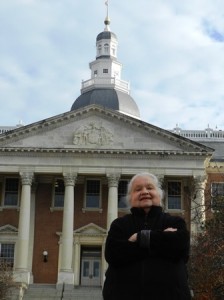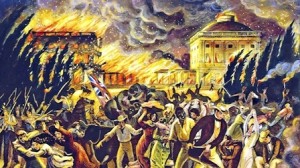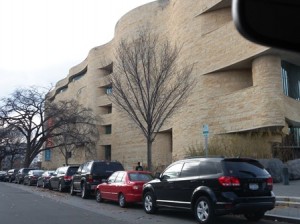» posted on Saturday, December 7th, 2013 by Linda Lou Burton
The Soup Bowl
 Linda Burton posting from Washington, DC – I call it “DC.” When I lived in Seattle if you said “Washington” folks thought you were referring to the state; Washington DC is considered the “other Washington” there. But I’m on the east coast today, easing into “the District” from Maryland and headed for the US Capitol, an icing-on-the cake post-stop in the Journey Across America. The majestic dome loomed tall as I approached; I circled in confusion and landed a parking spot on the other side. The Washington Monument was a few blocks to my right, covered in scaffolding due to earthquake repair. I coaxed the cats to the window to
Linda Burton posting from Washington, DC – I call it “DC.” When I lived in Seattle if you said “Washington” folks thought you were referring to the state; Washington DC is considered the “other Washington” there. But I’m on the east coast today, easing into “the District” from Maryland and headed for the US Capitol, an icing-on-the cake post-stop in the Journey Across America. The majestic dome loomed tall as I approached; I circled in confusion and landed a parking spot on the other side. The Washington Monument was a few blocks to my right, covered in scaffolding due to earthquake repair. I coaxed the cats to the window to  look; then tied my red wool scarf tight around my head before stepping out into the wind. Not a day for sightseeing. But people were out; a Chinese chorus was performing across the street; cameras were in evidence in every hand. Washington, DC! What is so special about this place? Why do 19 million visitors come every year? It’s exciting, and vibrant, that’s why; a bubbling soup bowl brimming with a little bit of everything. The resident population is 601,723 (US Census 2010), but that jumps to a million throughout the workweek; commuters pour in from the suburbs of Maryland and Virginia. After all, the centers of all three branches of the federal government are
look; then tied my red wool scarf tight around my head before stepping out into the wind. Not a day for sightseeing. But people were out; a Chinese chorus was performing across the street; cameras were in evidence in every hand. Washington, DC! What is so special about this place? Why do 19 million visitors come every year? It’s exciting, and vibrant, that’s why; a bubbling soup bowl brimming with a little bit of everything. The resident population is 601,723 (US Census 2010), but that jumps to a million throughout the workweek; commuters pour in from the suburbs of Maryland and Virginia. After all, the centers of all three branches of the federal government are  here – the Congress, the President, and the Supreme Court. Flags from all over the world fly here; count 176 foreign embassies. The headquarters of international organizations, trade unions, non-profits, and lobbying groups are here. There are more museums here than you could visit in a year; 19 within the Smithsonian alone. The architecture, park spaces, and memorials are stunning. You’ll find both inspiration and controversy here; it’s all in the soup.
here – the Congress, the President, and the Supreme Court. Flags from all over the world fly here; count 176 foreign embassies. The headquarters of international organizations, trade unions, non-profits, and lobbying groups are here. There are more museums here than you could visit in a year; 19 within the Smithsonian alone. The architecture, park spaces, and memorials are stunning. You’ll find both inspiration and controversy here; it’s all in the soup.
Washington, DC is the capital of the United States. The US Constitution says so; the District is under the exclusive jurisdiction of the Congress and is not part of any US state. Go back to July 16, 1790 for that decree, but first, get the timeline in your mind. We’ve recently been in Delaware, and learned of Caesar Rodney and his ride to Philadelphia on July 4, 1776, to vote Yes for Independence, and to sign that famous Declaration. We’ve recently been to the  Maryland State House, which served as the National Capitol for a time, and where George Washington resigned his post as commander of the Continental Army on December 23, 1783, before heading back to his Mt Vernon farm as a private citizen. We know how long that lasted – he was inaugurated as our first President in New York City on April 30, 1789. Philadelphia, Annapolis, New York?
Maryland State House, which served as the National Capitol for a time, and where George Washington resigned his post as commander of the Continental Army on December 23, 1783, before heading back to his Mt Vernon farm as a private citizen. We know how long that lasted – he was inaugurated as our first President in New York City on April 30, 1789. Philadelphia, Annapolis, New York?
Well yes, the meeting places of our various Congresses moved around quite a bit; all in all, eight cities in four different states served as “capital” until the decision was made to set aside a specific, non-state spot. Here’s the list.
- First Continental Congress (1774-1774): Philadelphia (PA)
- Second Continental Congress (1775-1781): Philadelphia (PA), Baltimore (MD), Lancaster (PA), York (PA)
- Congress under the Articles of Confederation (1781-1788): Philadelphia (PA), Princeton (NJ), Annapolis (MD), Trenton (NJ), New York (NY)
- Congress under the Constitution (1789-1800): New York (NY), Philadelphia (PA)
Till finally, Washington, DC.
Article One, Section Eight of the United States Constitution permitted the establishment of a “District (not exceeding ten miles square) as may, by cession of particular states, and the acceptance of Congress, become the seat of the government of the United States;” the Constitution didn’t specify a location however. Thomas Jefferson, Alexander Hamilton, and James Madison came up with a motivational plan – in exchange for land in the southern states, the federal government would pay each state’s remaining Revolutionary War debts.
It was July 9, 1790 when Congress passed the Residence Act; it approved the creation of a national capital on the Potomac River. President George Washington signed the bill into law  on July 16; he was charged with the responsibility of selecting the exact spot from land donated by the states of Maryland and Virginia. He chose a square area measuring 10 miles per side; totaling 100 square miles, and including the pre-existing settlements of Georgetown, Maryland and Alexandria, Virginia.
on July 16; he was charged with the responsibility of selecting the exact spot from land donated by the states of Maryland and Virginia. He chose a square area measuring 10 miles per side; totaling 100 square miles, and including the pre-existing settlements of Georgetown, Maryland and Alexandria, Virginia.
The borders were surveyed and boundary stones were placed at every mile point; some of the stones remain today; maybe I’ll come across a few of them while I’m here. The District was named “Columbia,” the poetic name that was in favor at the time; the federal city that was constructed was named in honor of President Washington.  Washington, District of Columbia, was first used as a meeting place for Congress on November 17, 1800.
Washington, District of Columbia, was first used as a meeting place for Congress on November 17, 1800.
A good story! But of course it wasn’t as simple as that; and over time, changes have been made. For instance, in 1846 Congress returned the land originally ceded by Virginia (retrocession); today’s District occupies 68.3 square miles of land; only that which was ceded by Maryland. Montgomery County, Maryland borders the District to the northwest; Prince George’s County, Maryland to the east; across the Potomac River to the south and west are Arlington and Alexandria, Virginia. The highest point in the District is in Fort Reno Park in northwest Washington (elevation 409 feet); the geographic center of the District is near 4th and L Streets NW.
Can you guess the unofficial motto of Washington, DC? I spotted it on a few license plates as I drove through. It is “Taxation Without Representation,” an ironic twist on a major issue of  the Revolutionary War. Residents of the District have less representation in Congress than residents of the 50 states; there is a non-voting, at-large Congressional delegate, but no senators. The 23rd Amendment, ratified in 1961, grants the District three electoral votes in presidential elections; in 1973 the District was allowed to begin some self-government with a locally elected mayor and a 13-member council; however Congress maintains supreme authority over the city, and may overturn local laws. Does this seem unfair? Many think so; various polls indicate that 80% of Americans believe District residents should have voting representation in Congress.
the Revolutionary War. Residents of the District have less representation in Congress than residents of the 50 states; there is a non-voting, at-large Congressional delegate, but no senators. The 23rd Amendment, ratified in 1961, grants the District three electoral votes in presidential elections; in 1973 the District was allowed to begin some self-government with a locally elected mayor and a 13-member council; however Congress maintains supreme authority over the city, and may overturn local laws. Does this seem unfair? Many think so; various polls indicate that 80% of Americans believe District residents should have voting representation in Congress.
But campaigns such as the DC statehood movement, and the proposed District of Columbia Voting Rights Amendment have not been successful. Opponents say the Founding Fathers never intended that District residents have a vote in Congress since the Constitution is clear that representation must come from the states. In addition, and as precedent, the District of Columbia Organic Act of 1801, which officially organized the District, placed the entire territory under the exclusive control of the federal government; after its passage citizens in  the District were no longer considered residents of a state, therefore ending their representation in Congress.
the District were no longer considered residents of a state, therefore ending their representation in Congress.
It’s complicated, in the soup bowl. Did you wonder why the land donated by Virginia was returned in 1846? That had to do with the slave trade; Alexandria was a major market and feared abolitionists in Congress would end slavery in the District; they petitioned to get their land back. There were the complications of the War of 1812, when British forces invaded the District. They burned the Capitol, Treasury, and White House. Most government buildings were repaired quickly; but the Capitol was under construction at the time; it wasn’t completed as you see it today until 1868. And that’s another complicated story.
 But enough for today. I’m beating daylight before dark; time to get to the hotel and unload the Scion; time to settle in with Alex and Jack; time to eat – Fancy Feast for them, a bowl of soup for me? I passed the National Museum of the American Indian as I headed down Independence Avenue; I saw the top of the Washington Monument behind some buildings I didn’t recognize. The traffic forced me to keep my eyes on the road; I’m sure the White House was somewhere to my right.
But enough for today. I’m beating daylight before dark; time to get to the hotel and unload the Scion; time to settle in with Alex and Jack; time to eat – Fancy Feast for them, a bowl of soup for me? I passed the National Museum of the American Indian as I headed down Independence Avenue; I saw the top of the Washington Monument behind some buildings I didn’t recognize. The traffic forced me to keep my eyes on the road; I’m sure the White House was somewhere to my right.
Stay tuned for more.
